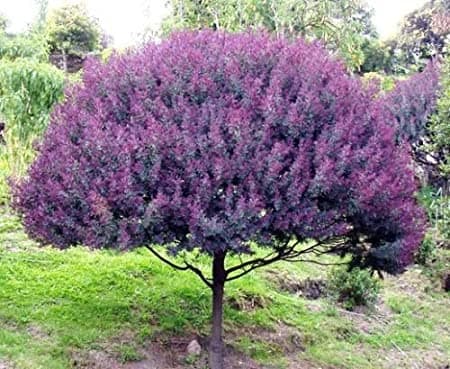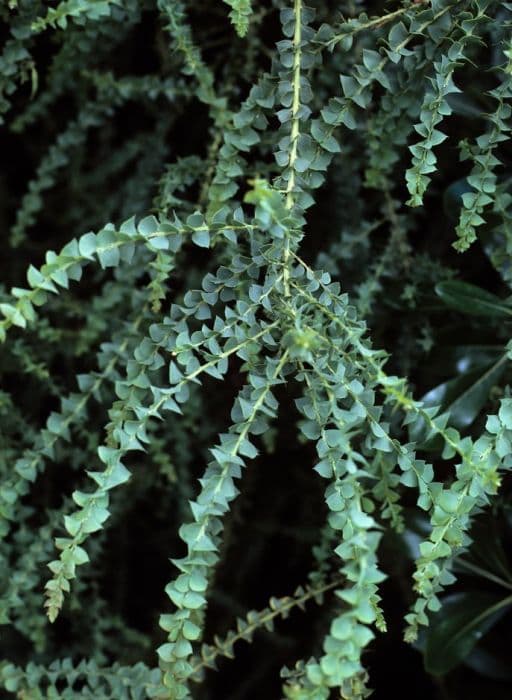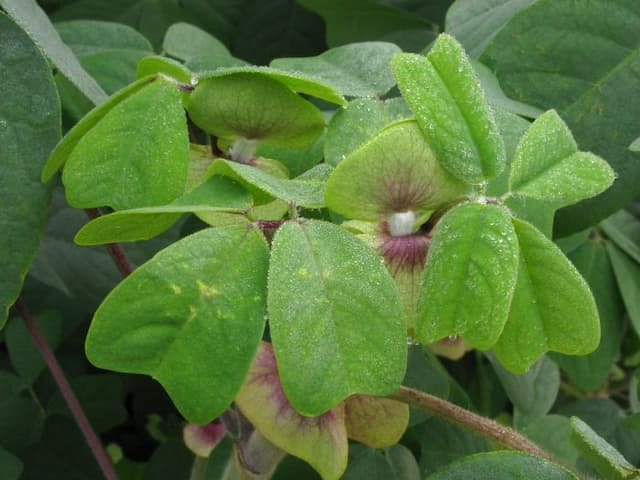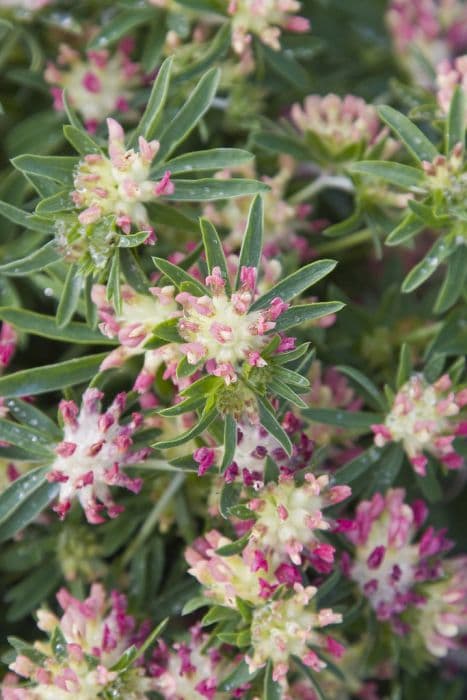Prairie Lupine Lupinus lepidus

ABOUT
The plant known as Prairie Lupine features a beautiful and striking appearance. This plant typically boasts palmately compound leaves, which means the leaflets spread out in a manner similar to the fingers on a hand from a central point. Green in color, these leaves provide a dense backdrop for the remarkable floral display above. Flowers of the Prairie Lupine are arranged in clusters on a spike, forming a showy, elongated arrangement. These blossoms can vary in color, usually presenting shades of blue, purple, or occasionally pink. Each individual flower has a distinctive shape, with a banner, wings, and a keel, which is characteristic of the pea family to which it belongs. The blooms are not only visually appealing but are also known to attract various pollinators. The stems that support both the leaves and the flowers are erect and emerge from a base that can be either woody or herbaceous, grounding the plant with substantial support. The entire plant is adorned with fine hairs, giving it a somewhat soft or silvery appearance in the right light. Overall, the Prairie Lupine is distinguished by its compound leaves and its striking floral spikes that contribute to its role as an eye-catching component of the ecosystems where it naturally occurs.
About this plant
 Names
NamesSynonyms
Prairie Lupine, Wedge-Leaf Lupine, Pacific Lupine, Lilac Sunbonnet, Lepidus Lupine.
Common names
Lupinus confertus, Lupinus lepidus var. lobbii, Lupinus lepidus var. utahensis, Lupinus lobbii, Lupinus sellulus.
 Toxicity
ToxicityTo humans
Lupine is considered toxic to humans due to the presence of alkaloids such as lupinine and sparteine. Ingestion of the plant, particularly the seeds, can lead to symptoms including dizziness, confusion, irregular heart rhythm, gastrointestinal upset, and abdominal discomfort. In severe cases, ingestion may result in respiratory depression and convulsions. Consumption of large amounts of lupine seeds should be particularly avoided, as it can result in significant toxicity.
To pets
Lupine is also toxic to pets, including dogs, cats, and horses. The alkaloids can cause similar symptoms as in humans, with potential signs of poisoning including vomiting, diarrhea, tremors, and lethargy. More severe cases can lead to respiratory depression and heart abnormalities. Ingestion of lupine can be particularly dangerous for pets, and prompt veterinary attention is advised if a pet consumes any part of the plant.
 Characteristics
CharacteristicsLife cycle
Perennials
Foliage type
Deciduous
Color of leaves
Green
Flower color
Blue
Height
1-2 feet (0.30-0.61 meters)
Spread
1-2 feet (0.30-0.61 meters)
Plant type
Herb
Hardiness zones
5
Native area
North America
Benefits
 General Benefits
General Benefits- Nitrogen fixation: Lupinus lepidus, commonly known as Prairie Lupine, enriches the soil by fixing atmospheric nitrogen through a symbiotic relationship with root bacteria.
- Pollinator attraction: The colorful flowers of the Prairie Lupine attract bees, butterflies, and other pollinators, which are crucial for the pollination of many other plant species.
- Erosion control: The root system of Prairie Lupine helps stabilize soil and prevent erosion, especially in disturbed areas or on slopes.
- Habitat enrichment: Prairie Lupine provides food and habitat for a variety of wildlife species, including caterpillars of the endangered Karner blue butterfly.
- Aesthetic appeal: With its vibrant purple flowers, Prairie Lupine adds visual interest and beauty to gardens and natural landscapes.
- Restoration potential: Due its ability to thrive in poor soil conditions, Prairie Lupine is often used in habitat restoration projects to help revitalize damaged ecosystems.
 Medical Properties
Medical PropertiesThis plant is not used for medical purposes.
 Air-purifying Qualities
Air-purifying QualitiesThis plant is not specifically known for air purifying qualities.
 Other Uses
Other Uses- Lupine seeds from Prairie Lupine, like other lupines, can be used as a protein-rich grain substitute if properly processed to remove alkaloids.
- The fibers from the Prairie Lupine plant can be used to create textiles and materials, though this is not a common practice due to limited commercial availability.
- Prairie Lupine can be implemented in a crop rotation scheme to enrich the soil with nitrogen, benefiting other plants grown after it.
- The vibrant flowers of the Prairie Lupine may be used in natural dye production, offering hues of blue and purple.
- The Prairie Lupine's robust root system can help in erosion control by stabilizing loose soils on slopes and disturbed areas.
- Dried Prairie Lupine plants can be used in floral arrangements and crafts for decorations that retain their shape and color for a long time.
- Leaves of the Prairie Lupine may be used in compost as a nitrogen-rich material, contributing to the overall health of the compost mix.
- Prairie Lupine can be planted in gardens as a trap crop, luring pests away from more valuable plants.
- When planted in orchards or vineyards, the Prairie Lupine can increase biodiversity, attracting beneficial insects that act as pollinators or predators of harmful pests.
- The plant can be used in educational settings, such as school gardens, to teach students about botany and the importance of native plants in ecosystems.
Interesting Facts
 Feng Shui
Feng ShuiThe Lupine is not used in Feng Shui practice.
 Zodiac Sign Compitability
Zodiac Sign CompitabilityThe Lupine is not used in astrology practice.
 Plant Symbolism
Plant Symbolism- Resilience: Lupinus lepidus, commonly known as Prairie Lupine, often thrives in harsh conditions, symbolizing the ability to overcome adversity.
- Innovation: The Prairie Lupine's ability to fix nitrogen in the soil represents innovation and improving one's environment.
- Devotion: With its perennial nature, the Prairie Lupine embodies long-standing and enduring devotion.
- Opportunity: The early blooming of the Prairie Lupine signals new opportunities and the start of a cycle.
 Water
WaterThe common name for Lupinus lepidus is the Prairie Lupine. To water this plant, provide deep watering to soak the root area, rather than frequent shallow waterings. This method encourages a strong root system. Watering should occur when the top inch of soil feels dry; for mature plants, this typically means once every week or two, depending on weather conditions. An average Prairie Lupine may require about 1 gallon of water every week during the growing season, but less during cooler or rainy periods.
 Light
LightThe Prairie Lupine thrives in full sunlight for optimal growth and flowering. A sunny spot with direct sunlight for at least 6 to 8 hours a day is ideal for this plant. Avoid placing the Prairie Lupine in deep shade, as it can lead to weak growth and fewer blooms.
 Temperature
TemperaturePrairie Lupines prefer a temperate climate with a temperature range that doesn't often fall below 20 degrees Fahrenheit or rise above 85 degrees Fahrenheit. They can survive light frosts, but consistent freezing temperatures or extreme heat can be detrimental. Ideally, keep them in a location where temperatures remain between 60 and 75 degrees Fahrenheit for most of the growing season.
 Pruning
PruningPrune Prairie Lupines to maintain plant health and appearance, and to encourage bushier growth with more blooms. Deadheading spent flowers can promote a second flush of blooms. Prune the plant after flowering, typically in late summer or early fall, by cutting back about one-third of the growth.
 Cleaning
CleaningAs needed
 Soil
SoilThe best soil mix for Prairie Lupine is well-draining with a slightly acidic to neutral pH between 6.0 and 7.0. A mixture of loamy soil, peat, coarse sand, and perlite or pumice will provide good aeration and drainage to support its growth.
 Repotting
RepottingPrairie Lupine does not need frequent repotting and can tolerate being slightly root-bound. It may only need repotting every two to three years, ideally in the spring before the growing season begins.
 Humidity & Misting
Humidity & MistingPrairie Lupine prefers moderate humidity levels, and it can adapt to the typical humidity conditions found outdoors in its native environment. It does not require any special humidity adjustments when grown in a garden setting.
 Suitable locations
Suitable locationsIndoor
Place Prairie Lupine by a sunny window and ensure good air circulation.
Outdoor
Plant in sun to part shade with good drainage.
Hardiness zone
4-8 USDA
 Life cycle
Life cycleLupinus lepidus, commonly known as Prairie Lupine, begins its life as a seed that germinates in late winter to early spring, breaking dormancy with sufficient chilling and moisture. Upon germination, the radical emerges and develops into a small rosette of leaves close to the ground as the plant establishes a root system. The rosette stage may last for several weeks to months, depending on environmental conditions. As temperatures rise and days lengthen, Prairie Lupine enters the vegetative growth stage, where it develops stems and a larger leaf area, preparing for reproduction. Flowering occurs in late spring to early summer, where it produces spikes of purple-blue flowers that are attractive to pollinators. After pollination, seeds develop in pods, and once mature, the seeds are dispersed, completing the cycle and remaining dormant until the next germination cycle is triggered.
 Propogation
PropogationPropogation time
Spring to early summer
The propagation of Lupinus lepidus, commonly known as the Prairie Lupine, is typically done through seed sowing. The best time to propagate Prairie Lupine by seeds is in the fall, which allows the seeds to undergo a natural stratification process during the winter months, breaking down their tough outer coats. To propagate by seeds, one must first scarify the seeds by gently rubbing them between two pieces of fine sandpaper or nicking them with a knife; this process helps water to penetrate the seed coat. After scarifying, the seeds should be soaked in water for 24 hours to further soften the coat. Sowing the seeds directly in the desired location or in pots filled with well-draining soil should follow. To ensure a good growth rate, covering the seeds with a thin layer of soil—about a quarter of an inch (approximately 6 millimeters)—is recommended. Regular watering, especially during dry spells, will ensure the seeds have the moisture they need to germinate effectively.









